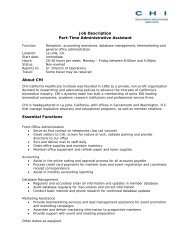California Biomedical Industry - California Healthcare Institute
California Biomedical Industry - California Healthcare Institute
California Biomedical Industry - California Healthcare Institute
Create successful ePaper yourself
Turn your PDF publications into a flip-book with our unique Google optimized e-Paper software.
Patient profileGerardo Becerra: Living with lupusIn the summer of 1981, GerardoBecerra was at the top of his game.He was working fulltime in thecirculation department at the UnionTribune in San Diego. He wasbetween his junior and senior yearsat San Diego State University, wherehe was earning his bachelor’s degreein social work. He was completing aninternship at a local nursing home,and he had been notified that hisapplication for U.S. citizenship hadbeen approved. He felt as if nothingcould go wrong.Until one day, he knew somethingwas not right when he began hittingthe snooze button. “I couldn’t wakeup,” he said. “It was taking me longerand longer to get out of bed, and Iwas exhausted all day.”So Becerra, who had “barely goneto a doctor ever,” sought help. “Fivedoctors and six months later,” hesaid, “in August of 1982, I wasdiagnosed with lupus.” He had neverheard of the condition and said theinformation he found at the library wasfrightening. He learned that lupus is achronic disease with no cure, and hisdoctor told him, “If you’re lucky, youmight have 15 years” of life expectancy.Lupus is an autoimmune disease thatcan damage any part of the body andmost commonly affects skin, joints and/or organs. It is a disease that “flares”between periods of relative remission.An estimated 1.5 million Americanshave lupus, with the majority of newpatients being women between the agesof 15 and 44.Complicating diagnosis and treatment,the disease progresses differently ineach patient and responds differentlyto medication from patient to patientand from year to year in the sameindividuals. Becerra said that he wasfortunate to have work that kepthim indoors and at a desk — withsupervisors who supported him. Foryears, only his immediate family andco-workers knew of his diagnosis. Thenhe became more actively involved inthe Lupus Foundation of Southern<strong>California</strong>, a San Diego-based patientinformation, support and advocacyorganization.He established the foundation’s firstsupport group for men with lupus,which still meets quarterly. Concernedthat information about the diseasewas not reaching patients of color —African-Americans, Hispanics, NativeAmericans and Asians — he helpedorganize community outreach activitiesthat work through ethnic groups’churches and civic centers. He alsohas become a frequent and poignantspeaker who is called upon oftento address legislators, researchers,industry, community groups, patientgroups and potential supporters aboutlupus.Now president of the organization,Becerra’s message is that patientscan live “as normal a life as possible”if they are diagnosed early, take careof themselves and work closely withtheir physicians to fine-tune andmonitor their therapeutic regimens.He also advocates for funding forfurther research, healthcare parity,and commercialization of newtherapies.Becerra believes the day couldcome when a cure for lupus isfound. He also believes that SanDiego institutions are playing asignificant part in that progress. Helisted Scripps, The Salk <strong>Institute</strong>and the biotech company, La JollaPharmaceuticals, among key localplayers. He also believes thatstem cell research holds particularpromise. “Stem cell research fundingis important,” he said, “becauseif we find a breakthrough for oneautoimmune disease, we’ll be closerto finding breakthroughs for the restof us.”It may have been 28 years sinceBecerra felt nothing could go wrong.Yet he is still focused on all that is ripeto go right.40 | <strong>California</strong> <strong>Biomedical</strong> <strong>Industry</strong> 2011 Report






